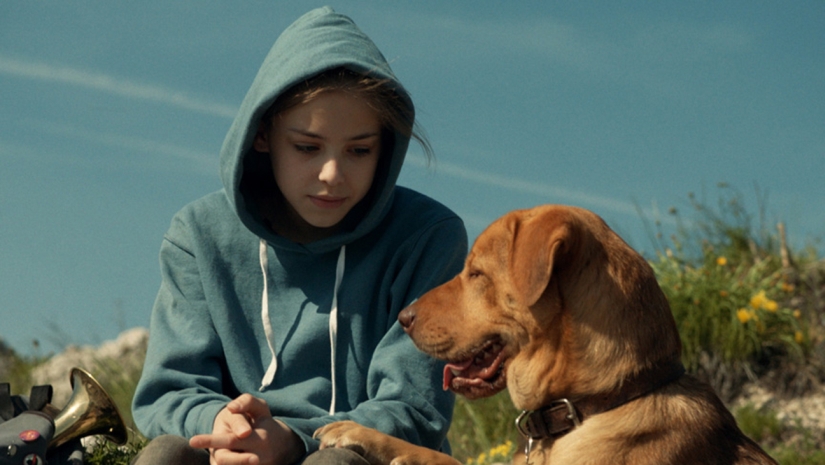Audacity is the primary strength of White God, Hungarian director Kornél Mundruczó’s political parable about a revolt of dogs against humanity, which is why the film opens with such a striking series of images: the stillness of an empty Budapest, a girl on a bike being chased by hundreds of strays. The wall of teeth and fur inspires a sense of horrified awe. It’s a nightmare; something out 28 Days Later and a nature-run-amok movie (e.g., The Birds).
The film then flashes back to show how we came to that point. The technique is structurally off-putting to me whenever it’s used, but Mundruczó understands the power and importance of those images. Not only are they striking (White God‘s marketing is built on these shots of canine revolution), they’re the heart of the film. That’s why as White God progressed, it felt as if the potency of that opening scene was diluted.
For that, we have the humans to blame.
[iframe id=”https://www.youtube.com/embed/kIGz2kyo26U” align=”center” mode=”normal” autoplay=”no” maxwidth=”825″]
White God (Fehér isten)
Director: Kornél Mundruczó
Rating: R
Release Date: March 27, 2015
The dog that leads the eventual stray uprising is Hagen (played by two dogs, siblings, Bodie and Luke). He belongs to 13-year-old Lili (Zsofia Psotta), the daughter of divorced parents who must go stay with her father (Sandor Zsoter) for a while. In her father’s building, residents who have mixed-breed dogs have to pay a tax, which leads to Hagen getting left on the side of the road to fend for himself.
The sequences with Hagen are fantastic and exhibit some of the best canine acting since Samuel Fuller’s White Dog, which used the reformation of an attack dog to explore racism as a learned behavior. (Coincidentally, one of the dog handlers on White God is the daughter of the handler from White Dog.) On his first day alone, Hagen ponders the corpse of another stray, pawing at it as if trying to stir the dog awake. He fails and ruminates in a way that’s all too human. Recognition dawns in his dark yet contemplative eyes, in the arch of his spine, in the angle of his ears and forepaws. Hagen’s journey is a rough one, leading him from one abusive master to the next, sold and traded and devalued with each subsequent transaction.
So much can be read into Hagen’s story. His first day or so is handled like a recreation of the immigrant experience, unmoored, startled by a new world, ushered into unfamiliar rules and customs. One smaller stray acts as a kind of guide for Hagen, showing him where other strays congregate and the harshness of animal control. When Hagen goes from master to master, the imagery recalls narratives of sexual slavery, sweat shop work, underground fights, and prisons. Mundruczó’s done such smart work to anthropomorphize the dogs and the situations. Rather than narrow focus to a specific kind of victimization, a multitude of human miseries can be read into these situations. The dogs function as the embodiment of the downtrodden in general—the poor, the weak, the disenfranchised, the undocumented, the discarded—and the world is merciless to them.
Hagen’s story is more than enough to carry White God as a film. Yet Mundruczó continually cuts back to a less engaging domestic drama and coming-of-age tale involving Lili and her father. The human stuff all seems rote rather than lived in, and marks a strange tonal shift from the raw, high-stakes political observations on Hagen’s side of the story. Lili and Hagen felt more perpendicular than parallel, and almost every time White God cut back to the humans, I felt less engaged with the film. It’s as if the master class held their pets back.
There’s also an issue of the last third of White God, which marks another major shift in tone and focus. By then we’ve returned to the dog uprising shown at the beginning, and the film begins to feel less like The Birds and more like The Birds II: Land’s End. The political dimension is still there and the imagery recalls, briefly, the London Riots and The Arab Spring, but it feels like the film has gone from a parable to a horror movie. Mundruczó even has a kind of slasher movie vibe in a few of the dog attacks on their human oppressors.
White God is a fascinating watch and ultimately aims high even though it’s all over the place. Yet like some movies in which certain parts hit me harder than others, I’m left thinking about the film conterfactually—many “what if’s” that outweigh what’s there. Mainly, I wanted more of that sense of anarchy hinted in the opening scenes; more meat for the metaphor, less restraint of the beasts. The revolution will not be sentimentalized (at least not totally), but maybe it was just a little bit anesthetized.


